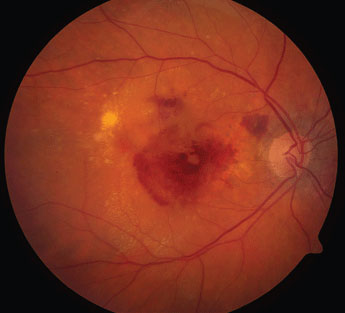 |
|
Though it’s rare for patients on anti-VEGF for nAMD or glaucoma to have both diseases, those who do—and those at risk—should be monitored closely. Click image to enlarge. |
The mainstay treatment for patients with neovascular age-related macular degeneration (nAMD) is intravitreal anti-VEGF; however, some studies have suggested that this intervention may increase a patient’s risk of glaucoma and ocular hypertension. After performing a recent analysis to evaluate the potential association, a team of researchers concluded that glaucoma seemed to accelerate more rapidly in affected patients on anti-VEGF therapy for nAMD.
The single-center, retrospective study using real-world data included 6,314 glaucoma patients and 2,166 nAMD patients treated between 2008 and 2017. Glaucoma progression was evaluated based on the following clinical data: visual field change (mean deviation [MD], dB/year), IOP (mm Hg/year) and fundus photos (graded “yes” or “no” depending on the presence of progression). These findings were compared in glaucoma eyes with vs. without anti-VEGF treatment for nAMD that had at least one year of follow-up.
In glaucoma eyes receiving anti-VEGF injections, the mean change in MD was -0.70dB/year compared with -0.27dB/year in glaucoma eyes without anti-VEGF. The researchers also detected glaucoma progression in 14 of 20 fundus photos of eyes with anti-VEGF treatment compared with 10 of 20 fundus photos of untreated fellow eyes.
“We found a statistically significant faster rate of visual field progression among 37 glaucomatous eyes with anti-VEGF treatment for nAMD compared with a control group of 4,304 eyes with glaucoma and without anti-VEGF for nAMD,” the researchers wrote in their paper. “There also was a trend toward a higher rate of visual field progression among 20 eyes with anti-VEGF treatment for nAMD compared with their 20 untreated fellow eyes.”
The researchers also investigated how often the two diseases coexisted in patients on anti-VEGF. They found that the incidence was rare; out of 8,470 patients in the cohort with either nAMD or glaucoma and receiving injections, only 147 were affected by both diseases. Over the 10-year period, 2% of patients with glaucoma received anti-VEGF therapy for nAMD, and 7% of those with nAMD had glaucoma, which the researchers noted agrees with the general population prevalence of each disease.
The researchers concluded that while it’s not common for the two diseases to coexist, patients on anti-VEGF therapy for nAMD who also have or develop glaucoma should be closely monitored to assess the potential influence of treatment-induced IOP spiking.
Pirinen I, Leinonen S, Helminen M, et al. Glaucoma progression in patients receiving intravitreal anti-VEGF treatment for neovascular age-related macular degeneration. Acta Ophthalmol. November 17, 2022. [Epub ahead of print]. |

